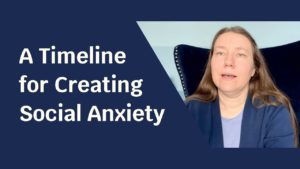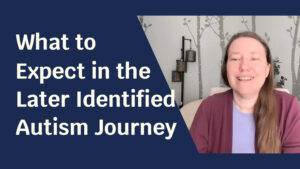
Why ask about reactions?
I was just speaking with an autistic woman and she was asking for some explanation about why I sometimes ask about physical reactions, especially when there’s a clear emotion happening. Or when we’re trying to talk about what she wants, versus what she thinks she wants (trying to get herself to do things), versus ‘what do I actually want in the situation?’
And so, a lot of what I end up doing with clients is essentially learning to build up a sense of self-trust. A sense of knowing what is right for you and what’s not okay for you. Because a lot of us have been conditioned, often unintentionally but still very heavily, to deny aspects of our own experience.
When we start to get in touch with our physical reactions towards things, we start to gain information about what we really feel about things, what we really think about things. Because our body reactions, our nervous systems, have had years and years and decades of experiences reacting to things.
We can ignore those. We can deny them. We can numb them. We can pretend they don’t exist. We can do all sorts of things to discount them. But they’re still there. Or they can be (if you start to get in touch with them, they will come back.)
We can do all sorts of things to discount them, but they’re still there.
But the thing is that, whether we are aware of what’s going on or not, our body will react entirely truthfully to a situation. If you don’t like something, it will react like ‘I don’t like this’. Often that appears as a tightness of muscles, tension, unpleasant tingling, unpleasant electricity, clenching, pain, all sorts of negative types.
Contraction reactions are very common. Pain reactions are very common. Bracing reactions are very common. But those are all your body’s signals of ‘no’, or ‘I don’t like this’, or ‘this is not okay for me’. And it could be about a person, a place, a situation, a particular bit in the sensory environment.
But as you start to get in touch with those (and you can get in touch with them simply by asking, “what am I noticing in my body right now?”), you can start to tap into that information and your body will give you more and more of that information.
It’s not overwhelming – or at least it doesn’t have to be as you get used to this, as you start to learn how to use it usefully – it’s not as overwhelming as just having all of the sensations but having no idea what to do with it, or not being able to do anything useful with it.
The other half of the body sensations though, are ‘yes’ signals. Very common ‘yes’ signals are any kind of opening, feeling like your chest is opening, or relief, or ‘burden off your shoulder’ kind of feelings.
It can be a pleasant tingling or a pleasant electricity. It can be the muscles relaxing. It can be a feeling of lightness or excitement. Any of these kinds of feelings. A feeling of softening is common as well. Any of those are ‘yes’ signals from bodies, or at least they’re very common yes signals. It’s good to get to know your own.
Learning from your signals
That’s the whole point of asking these questions, learning about this database essentially. You have the database, you have decades of information stored in your body about what’s okay and what’s not. It’s learning how to read the database, it’s learning how to access the database.
So that’s why I ask these questions. And it’s not a lot, I don’t dwell on the body stuff extensively, but just asking the question every now and then (especially when I notice a particular emotional reaction) starts to tie in the brain very subtly, and very non-overwhelmingly, that “hey, there’s an emotion, there’s a physical reaction and there’s a thought.”
It’s this triad, it’s this triangle of emotion. Physical, sensation, and thought, they always go together, there’s always the three. We may not pay attention to all three of those, but as we start to do that, we connect them. And when we notice one of them, we can look for the information from the other two.
We may not pay attention to all three of those, but as we start to do that, we connect them.
And sometimes we’ll notice the emotion feeling more. Sometimes we’ll notice the physical sensation more. Sometimes we’ll notice the thought (that will be the more dominant one for a lot of autistics, this tends to be the first one we go to).
But we can start to connect these simply by asking the question with curiosity, with no judgment, just like, “What’s the physical sensation there? What’s the emotion there?” And when you notice one of those, “What’s the thought underlying it?”
It can be useful to build that up. And those connections will start to build up on their own, as you ask these questions off and on, once in a while, in your normal course of life or when talking to a life coach like me.
Okay, so I hope that helps explain a little bit about what I’m doing and how this can work, how you can start to build these connections.
Oh, by the way, I was talking about building self-trust at the beginning.
How this ties into self-trust
When you have access to this database of information, and you start to notice, “here’s my ‘no’ signal and here’s my ‘yes’ signal”, you can use those when you’re trying to make decisions. Like, “Should I go to this place? How do I feel about that?”
When you imagine actually going to the place, not just thinking about the pros and cons about it, but imagine yourself going there – what are the physical sensations that come up? What are the emotional reactions?
And start asking, “Okay, so what is it about it that is causing that reaction? Is it the whole thing? That’s not really useful as a data point. But is it the people that are there? Is it a single person who might be there? Is it the environment, like the sensory experience is just overwhelming at that type of place? Is it a particular thing, or many things?”
You can learn to narrow it down.
But as you get better and better at that, and as you can narrow it down (which will happen with practice and experience), you can make better and better decisions about what’s good for you. And as you make decisions, and it turns out well more and more often, that builds self-trust from a place of actual experience of, “I did this. I made this decision and it turned out well. This was the right choice for me.”
That’s evidence that you can do it. And as that builds up, it builds self-trust very naturally.
Okay, so that’s how that all ties in. I hope this was useful. There are more posts like this if you’re interested in my content. I will wish you a neurowonderful day, take care.




